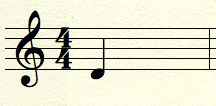Modes of the Major Scale
A scale or mode is a collection of pitches. In a previous post, I’ve explained the forms of the minor scale. Today examine the modes of the major scale.
The Modes
There are seven modes. What makes each mode unique is the arrangement of whole and half steps within the scale. Here’s the modes:
- Ionian (the major scale)
- Dorian
- Phrygian
- Lydian
- Mixolydian
- Aeolian (the natural minor scale)
- Locrian
Ionian is just another name for the major scale; Aeolian is another name for the minor.
Breaking it Down (the easiest way possible)
Some people suggest that each mode should be learned and practiced individually. I disagree. Simply put, each mode is derived from a major scale. Let’s take a look and the modes found in a C major (ionian) scale.
The Ionian mode (major) will contain the notes:
C D E F G A B C
The dorian mode is the same pitches but starts on D, rather than C:
D E F G A B C D
Phyrgian:
E F G A B C D E
Lydian:
F G A B C D E F
Mixolydian:
G A B C D E F G
Aeolian (minor):
A B C D E F G A
Locrian:
B C D E F G A B
So we can see that we haven’t really change anything except the order of the notes, which effects the order of half and whole steps.
Reversing the Process
This is one of a beginning theory classes favorite questions:
Write a (insert mode name) mode from the following root notes.
Let’s say the questions was: Write the Phrygian mode from that D root. We can break this down into a few steps.
- We know that the phrygian starts on the third note of the major scale. So what major scale is D the third note of? Bb
- What accidentals does the key of Bb contain? Bb and Eb. Keep that in mind for later
- Fill in the notes from D to the next octave higher, don’t worry about accidentals

- Add the accidentals we found in step 2

- DONE! That’s the Phrygian scale with the root of D
There are other ways to do this as well, but this is the easiest. Try coming up with the other modes from with the root of D.


Issy
When do modes get referred to?? Why learn them?
Christopher Davis
Hi Issy,
Modes are often refered to for soloing and improvising. It’s more important to realize that each mode contains the same notes as some major scale. A d Dorian mode has the same notes as a C major scale. So, rather than learning a “d dorian mode” on the guitar, you just learn to related it to C major. Example: You’d like to play a d-dorian mode over a D minor chord. Instead of learning an entirely separate scale, you just play a C major scale (which, presumably) you already knew.
Modes also come up when analyzing some music. “Modal mixture” (see here: http://www.classicalguitarblog.net/2009/03/modal-mixture/ ) is borrowing notes from parallel scales. That is, if you’re in C major, you can borrow notes from a C minor (C Aeolian) scale. That would give you a Bb, Eb and Ab to use rather than a B, E and A.
-CD
David
Hey thanks this is very simple, easy to understand.